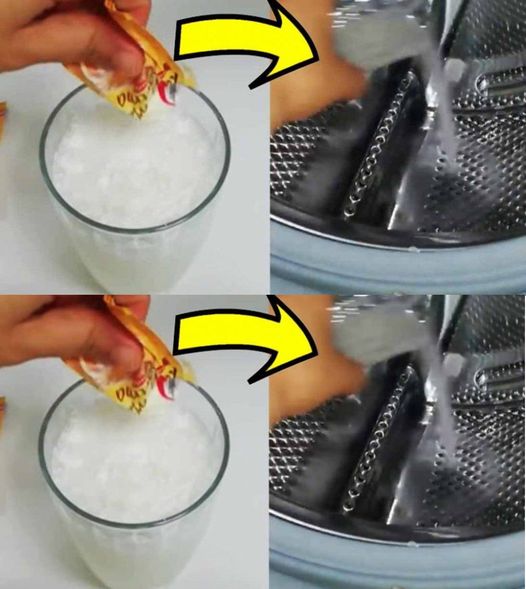ADVERTISEMENT
### **How to Use Yeast and Vinegar to Clean Your Washing Machine**
Now that we understand the science behind yeast and vinegar, it’s time to put them to use in your washing machine. Here’s how you can use these ingredients to eliminate odors and prevent mold and mildew growth:
#### **Step 1: Gather Your Ingredients**
To perform this simple cleaning trick, you will need the following ingredients:
– **1 cup of white vinegar**
– **1 tablespoon of active dry yeast**
– **A clean cloth or towel**
– **Access to your washing machine**
#### **Step 2: Add the Vinegar to the Drum**
Start by adding 1 cup of white vinegar directly into the drum of your washing machine. The vinegar will work to break down detergent residues, kill bacteria, and neutralize odors. Vinegar also helps dissolve mineral build-up and softens fabrics, making it a great choice for keeping your washer fresh and clean.
#### **Step 3: Add the Yeast**
Once the vinegar is in the drum, sprinkle 1 tablespoon of active dry yeast directly into the washing machine. The yeast will not only contribute to the cleaning process but will also help balance the acidity inside the machine, creating a less hospitable environment for mold and mildew growth.
#### **Step 4: Run a Hot Water Cycle**
With the vinegar and yeast mixture in the drum, close the washing machine door and set it to run a hot water cycle. The hot water helps activate the yeast and allows the vinegar to penetrate all the hidden areas of the washing machine, including the door seal, detergent tray, and drain.
If your machine has a “cleaning cycle” or “tub clean” setting, this would be the ideal time to use it. The cycle should last around 30 to 60 minutes, depending on your washing machine model.
#### **Step 5: Wipe Down the Interior**
Once the hot water cycle has completed, open the washing machine door and allow it to cool for a few minutes. Using a clean cloth or towel, wipe down the drum, rubber seals, and any other areas that might have picked up residue or moisture. Pay special attention to the rubber gasket around the door, as this area tends to trap moisture and mold.
#### **Step 6: Leave the Door Open**
After cleaning, leave the washing machine door open to allow any remaining moisture to evaporate. This helps prevent mold growth and keeps the machine smelling fresh.
—
### **Additional Tips for Maintaining a Fresh Washing Machine**
To ensure that your washing machine remains free of mold, mildew, and odors, there are a few additional maintenance tips that you can follow:
1. **Leave the Door Open After Use**: After each wash, leave the washing machine door slightly ajar for a few hours to allow air circulation. This helps prevent moisture from accumulating inside the drum, which can lead to mold and mildew growth.
2. **Clean the Rubber Seal**: Regularly inspect the rubber door seal for any signs of mold or detergent build-up. Wipe it down with a cloth soaked in vinegar or mild soap and water to keep it clean.
3. **Use the Right Amount of Detergent**: Using too much detergent can cause build-up in your washing machine. Make sure to use the appropriate amount of detergent for each load to prevent soap residue from accumulating in the drum.
4. **Run Monthly Cleaning Cycles**: Once a month, run a cleaning cycle with vinegar and yeast to keep your washing machine in top shape. This will help prevent the build-up of residues and mold.
5. **Clean the Drain Filter**: If your washing machine has a drain filter, make sure to clean it regularly. Over time, lint, debris, and residue can clog the filter, leading to unpleasant odors.
—
### **Why Yeast and Vinegar Are a Game-Changer for Your Washing Machine**
Using yeast and vinegar in your washing machine is a game-changer because it’s an affordable, eco-friendly, and effective method to maintain a clean and fresh-smelling washing machine. Unlike harsh chemicals that may be harmful to your health and the environment, yeast and vinegar offer a safe, natural alternative for tackling the most common washing machine problems.
The best part? Yeast and vinegar are inexpensive and widely available, making this solution accessible to everyone. You don’t need to invest in specialized cleaning products or worry about the potential dangers of chemical cleaners.
By incorporating this simple and natural cleaning routine into your regular laundry maintenance, you can ensure that your washing machine remains in optimal condition, free of odors and mold, and ready to keep your clothes fresh for years to come.
—
### **Conclusion: The Power of Natural Ingredients in Household Maintenance**
The combination of yeast and vinegar in the washing machine is a prime example of how natural ingredients can offer powerful solutions for everyday household problems. By understanding how these ingredients work together to eliminate odors, mold, and mildew, you can take control of your washing machine’s maintenance and keep it running efficiently without the need for harsh chemicals.
So, the next time you notice a musty odor coming from your washing machine, try the yeast and vinegar trick! It’s simple, effective, and natural—and it just might become your go-to method for keeping your washing machine in top condition.
